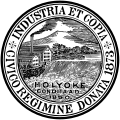Hampden Park Historic District | |
 Veterans Park (formerly Hampden Park) | |
| Location | Holyoke, Massachusetts |
|---|---|
| Coordinates | 42°12′30″N72°36′30″W / 42.20833°N 72.60833°W |
| Area | 5 acres (2.0 ha) |
| NRHP reference No. | 12000781 [1] |
| Added to NRHP | September 10, 2012 |
Veterans Park is a city park in the downtown area of Holyoke, Massachusetts. Originally called Hampden Park when it was given to the city by the Holyoke Water Power Company in 1861, it was rededicated in 1962 to honor the city's military veterans. The park and a few surrounding buildings were listed on the National Register of Historic Places in 2012 as the Hampden Park Historic District. Included in this designation are St. Jerome's Church (built during the late 1850s), the Convent of the Sisters of Notre Dame de Lourdes (1869), and the former Central Fire Station (1914), and other buildings. [2]


